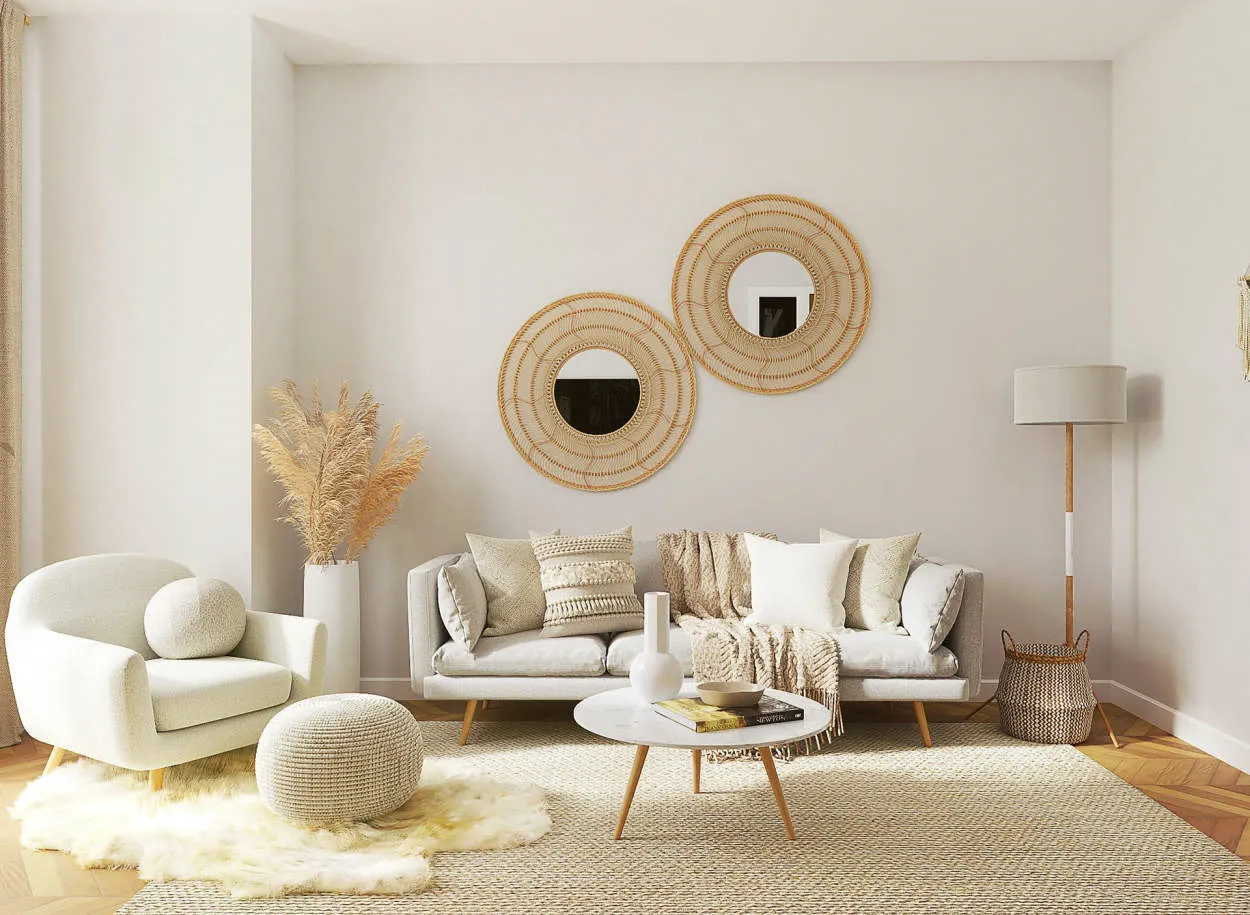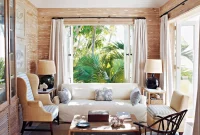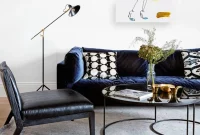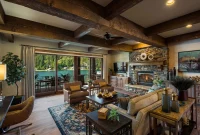Creating a harmonious home is essential for promoting well-being and balance in our lives. In this article, we explore the power of decor in creating a peaceful and serene environment that nourishes our mind, body, and soul. Discover simple yet effective tips and ideas to transform your living space into a sanctuary of tranquility and positive energy.
Incorporating Elements of Feng Shui

Creating a harmonious home goes beyond simply selecting stylish furniture and decoration. By incorporating elements of Feng Shui, you can enhance the energy flow and promote a sense of well-being and balance in your living space.
The Five Elements
Feng Shui recognizes the importance of the five elements: Wood, Fire, Earth, Metal, and Water. To achieve a harmonious environment, it is essential to incorporate these elements thoughtfully.
Wood
Representing growth and vitality, wood elements can be introduced through wooden furniture, plants, or artwork depicting trees. These elements can promote creativity and a sense of renewal.
Fire
The fire element symbolizes passion, energy, and transformation. Incorporate it through the use of candles, fireplaces, or warm-toned decorations. However, be mindful of striking a balance, as an excess of fire elements can lead to restlessness.
Earth
Earth elements bring stability, grounding, and nourishment. Introduce them using stones, ceramics, or earthy colors. These elements can foster a sense of security and promote a connection to nature.
Metal
Metal signifies clarity, efficiency, and focus. Incorporate metal elements through metallic finishes, mirrors, or metal decor items. These elements can support mental sharpness and organization.
Water
Water elements represent calmness, purity, and abundance. You can include water features like a small fountain or use mirrors to create a sense of flow. However, avoid excessive water elements to prevent an overwhelming or stagnant atmosphere.
Clutter-Free Environment
In Feng Shui, clutter is believed to obstruct the flow of energy. Ensure your home is organized and free from unnecessary items. A clutter-free environment can promote a calm and peaceful atmosphere.
Balance and Placement
Feng Shui emphasizes the balance of yin and yang energies. Arrange furniture in a way that creates a harmonious flow. Use a combination of curved and straight lines, light and dark colors, and vertical and horizontal shapes to achieve a balanced arrangement.
Natural Light and Fresh Air
Maximize natural light in your home to invite positive energy. Use sheer curtains or blinds to let sunlight in, and open windows regularly to allow fresh air circulation. Natural light and fresh air can invigorate the space and promote a sense of vitality.
Personal Connection
An essential aspect of Feng Shui is personalization. Surround yourself with meaningful objects, family photos, or artwork that resonates with you. These personalized elements can create a sense of comfort and nurture positive energy.
Decor for Mental and Emotional Well-being
In the quest for a harmonious home, the power of decor should not be underestimated. The way we decorate our living spaces can greatly impact our mental and emotional well-being, fostering a sense of balance and tranquility. By carefully selecting and arranging elements, we can create an environment that promotes a positive mindset and overall wellness.
1. Colors
Colors play a crucial role in influencing our mood and emotions. Opting for soothing and calming colors such as blues and greens can promote a sense of serenity and relaxation. These colors have been shown to reduce stress levels and create a peaceful ambiance.
2. Natural Elements
Bringing nature indoors through the use of plants, flowers, and natural materials can have a profound impact on our well-being. Not only do plants purify the air, but they also create a connection to the natural world, providing a sense of calm and vitality. Additionally, incorporating natural materials like wood and stone can add warmth and grounding to the space.
3. Lighting
The right lighting can significantly influence our mood and energy levels. Natural light is ideal, as it enhances our well-being and improves productivity. Maximizing the amount of natural light in your home by opening curtains or placing mirrors strategically can create a bright and uplifting atmosphere. For evenings or areas with limited natural light, consider incorporating soft, warm lighting options that create a cozy and inviting ambiance.
4. Clutter-Free Spaces
A cluttered and disorganized environment can lead to feelings of stress and anxiety. Creating clean and clutter-free spaces can promote a sense of calm and clarity. Use storage solutions to keep belongings organized and minimize visual distractions to foster a peaceful state of mind.
5. Personal Touches
Lastly, make sure to incorporate personal touches that bring joy and comfort. Display photographs, artwork, or cherished items that hold positive memories. Surrounding yourself with sentimental objects will evoke a sense of happiness and well-being.
By carefully considering the decor in our homes, we can create a sanctuary that supports our mental and emotional well-being. From colors and natural elements to lighting and personal touches, every detail impacts our overall sense of harmony and balance.
Balancing Aesthetics and Functionality
In the modern pursuit of creating a harmonious home, both aesthetics and functionality play vital roles. When it comes to designing a space that fosters well-being and balance, finding the perfect balance between these two elements is essential.
Aesthetics refer to the visual appeal of a space. It involves choosing colors, patterns, textures, and decorative items that resonate with the homeowner’s personal style and preferences. Aesthetically pleasing environments can evoke positive emotions, contribute to relaxation, and create a sense of serenity.
On the other hand, functionality is about ensuring that every aspect of the home serves a purpose and enhances the daily lives of its occupants. It involves thoughtful consideration of room layouts, furniture choices, and storage solutions. A functional home promotes efficiency and reduces clutter, allowing individuals to navigate their space with ease.
When aesthetics and functionality merge seamlessly, a home becomes more than just a dwelling; it becomes a sanctuary that nurtures well-being. Here are a few tips to strike the right balance:
-
Decluttering:
Start by decluttering your space, getting rid of unnecessary items, and keeping only what sparks joy. This not only enhances functionality but also creates a clean and organized canvas for your aesthetic choices.
-
Natural Elements:
Incorporate natural elements such as plants, natural lighting, and materials like wood and stone. These elements not only add beauty to a space but also have a calming effect on our minds, promoting well-being.
-
Flexible Furniture:
Opt for furniture that serves multiple purposes. This allows you to maximize functionality while maintaining a visually appealing environment. Consider pieces that offer storage options or can be easily rearranged to adapt to your changing needs.
-
Color Palette:
Choose a color palette that reflects your desired mood and energy for each space. Soft, soothing colors promote relaxation, while vibrant colors can energize and invigorate. Find the perfect balance that suits your preferences and ensures a welcoming atmosphere.
Striking a balance between aesthetics and functionality in home decor is a journey that requires thoughtful consideration and creativity. By thoughtfully integrating elements that bring beauty, comfort, and practicality, you can create a space that truly fosters well-being and balance for you and your loved ones.
Eco-Friendly Decor for a Healthy Environment
In today’s fast-paced world, creating a harmonious home that promotes well-being and balance is essential. One way to achieve this is by incorporating eco-friendly decor into your living space. By opting for sustainable and environmentally friendly choices, you not only contribute to a healthier planet but also improve the air quality and overall ambiance of your home.
One of the simplest ways to introduce eco-friendly decor is by using natural materials. Choose furniture made from sustainably sourced wood or bamboo, which are renewable resources. Additionally, opt for upholstery fabrics that are made from organic materials, such as cotton or hemp. These choices not only add a touch of nature to your home but also minimize your carbon footprint.
Another aspect to consider is lighting. Replace traditional, energy-consuming light bulbs with energy-efficient ones, such as LED bulbs. These bulbs not only last longer but also consume significantly less electricity, saving both energy and money. Additionally, make use of natural light as much as possible by allowing sunlight to stream into your space through well-placed windows or skylights.
When it comes to decorative elements, opt for indoor plants. Not only do they add a refreshing touch of greenery to your surroundings, but they also purify the air by removing harmful toxins. Choose low-maintenance plants that thrive in indoor environments, such as peace lilies or spider plants.
Lastly, consider incorporating sustainable storage solutions into your home. Choose storage containers made from recycled materials, such as glass or bamboo. By reducing the use of plastic and opting for eco-friendly alternatives, you help reduce waste and promote a healthier environment.
Creating a harmonious home that fosters well-being and balance is not limited to aesthetic elements alone. By embracing eco-friendly decor, you make a positive impact on both your immediate surroundings and the planet as a whole, creating a healthier and more sustainable space for yourself and future generations.
Personalizing Spaces for Inner Peace
In the quest for a harmonious home that promotes well-being and balance, it is essential to personalize our living spaces. The environment we live in greatly affects our state of mind and overall sense of serenity. By incorporating elements that resonate with our individuality, we can create a sanctuary that nurtures inner peace.
One way to personalize your space is through meaningful artwork. Choose pieces that evoke positive emotions and reflect your personal taste. Whether it’s vibrant abstract paintings or serene nature-inspired photographs, surrounding yourself with art that speaks to you can uplift your spirits and create a calming atmosphere.
Another aspect to consider is the use of natural elements. Introduce plants and greenery into your home to bring a sense of vitality and freshness. Not only do plants purify the air, but they also connect us to nature and promote a peaceful ambiance. Additionally, incorporating natural materials, such as wood or stone, can add a grounding and organic touch to your space.
A clutter-free and organized environment is essential for fostering inner peace. Decluttering not only physically clears space but also has a profound effect on mental clutter. Embrace minimalism by letting go of unnecessary belongings, organizing your possessions, and creating designated spaces for each item. With a tidy and neat space, you can cultivate a sense of tranquility and promote mental clarity.
Lighting plays a crucial role in setting the mood of a space. Opt for soft, warm lighting to create a soothing and relaxing ambiance. Dimmers and candles can further enhance the atmosphere and add a touch of intimacy. Experiment with different lighting techniques and find what works best to enhance your well-being.
Lastly, consider incorporating personal rituals into your daily routine. Create a designated space for activities like meditation, journaling, or practicing yoga. This area can serve as a visual reminder to prioritize self-care and allow for moments of introspection and calmness.
Remember, each person’s definition of harmony and well-being may differ, so it’s crucial to personalize your space to align with your unique needs. By infusing your personality and preferences into your surroundings, you can create a haven that fosters inner peace and allows you to recharge and find balance in the comfort of your own home.
Color Psychology in Home Design
In the quest to create a harmonious home, the choice of colors within our living spaces is crucial. Color psychology, the study of how colors can affect our emotions and moods, plays a significant role in home design. By strategically incorporating certain hues, we can foster well-being and balance within our living environment.
The Power of Warm Colors
Warm colors such as red, orange, and yellow can create a sense of warmth and coziness in a room. These vibrant hues evoke feelings of energy and excitement, making them suitable for areas where socializing and activity take place, like living rooms and kitchens.
The Serenity of Cool Colors
Cool colors like blue, green, and purple have a calming effect on the mind and body. These colors promote relaxation and tranquility, making them ideal for bedrooms and study areas. Lighter shades can help open up smaller spaces, while darker tones add depth and richness to larger rooms.
The Balancing Act of Neutral Colors
Neutral colors, including white, beige, and gray, act as a canvas for other colors in the room. They provide a sense of balance and harmony, helping to create a cohesive and timeless design. Neutral tones also allow for easy adaptation to changing trends and personal preferences.
The Impact of Accent Colors
Incorporating accent colors into home decor can add visual interest and personality to a space. Accent colors are often bolder and contrasting, serving to highlight specific elements or areas within a room. These pops of color can be introduced through furniture, artwork, accessories, or even a feature wall.
The Importance of Personal Preference
While color psychology can provide insights into the emotional impact of different hues, it’s essential to remember that personal preference plays a significant role in home design. Ultimately, the colors chosen for a home should resonate with the individual or family living in it, reflecting their unique tastes and preferences.
Conclusion
In conclusion, creating a harmonious home through well-thought-out decor choices is essential in fostering well-being and balance in our lives. By incorporating elements that promote tranquility, functionality, and personal expression, we can create spaces that inspire and rejuvenate us. From soothing color palettes to decluttered and organized environments, our homes can become sanctuaries that enhance our overall quality of life.



